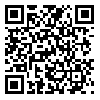Volume 8, Issue 25 (Summer 2014)
IJT 2014, 8(25): 1054-1059 |
Back to browse issues page
Hossein Hassanian-Moghadam1 
 , Mohammad Reza Zarei2
, Mohammad Reza Zarei2 
 , Vahid Eslami2
, Vahid Eslami2 
 , Ali Zandieh2
, Ali Zandieh2 
 , Gohar Fakhfouri3
, Gohar Fakhfouri3 
 , Marjan Rasouli *
, Marjan Rasouli * 
 4, Patricia Khashayar5
4, Patricia Khashayar5 
 , Mohammad Reza Rasouli2
, Mohammad Reza Rasouli2 


 , Mohammad Reza Zarei2
, Mohammad Reza Zarei2 
 , Vahid Eslami2
, Vahid Eslami2 
 , Ali Zandieh2
, Ali Zandieh2 
 , Gohar Fakhfouri3
, Gohar Fakhfouri3 
 , Marjan Rasouli *
, Marjan Rasouli * 
 4, Patricia Khashayar5
4, Patricia Khashayar5 
 , Mohammad Reza Rasouli2
, Mohammad Reza Rasouli2 

1- Department of Clinical Toxicology, Loghman-Hakim Hospital, Shahid Beheshti University of Medical Sciences, Tehran, Iran.
2- Sina Trauma and Surgery Research Center, Tehran University of Medical Sciences, Tehran, Iran.
3- Department of Pharmacology, School of Medicine, Shahid Beheshti University of Medical Sciences, Tehran, Iran.
4- School of Nursing, Islamic Azad University of Qom, Qom, Iran. , mhr_rasouli@yahoo.com
5- Endocrinology and Metabolism Research Institute, Tehran University of Medical Sciences, Tehran, Iran.
2- Sina Trauma and Surgery Research Center, Tehran University of Medical Sciences, Tehran, Iran.
3- Department of Pharmacology, School of Medicine, Shahid Beheshti University of Medical Sciences, Tehran, Iran.
4- School of Nursing, Islamic Azad University of Qom, Qom, Iran. , mhr_rasouli@yahoo.com
5- Endocrinology and Metabolism Research Institute, Tehran University of Medical Sciences, Tehran, Iran.
Abstract: (5444 Views)
Background: There is no clear data on the adherence of emergency medical services (EMS) paramedics and hospital staff rather than those working in poisoning centers to the guidelines for managing acutely poisoned patients in developing countries.
Methods: During a 6-month period, all EMS-managed poisoned patients along with those initially managed in a non-poisoning center before being referred to a poisoning hospital in Tehran, Iran, were instructed. Then the indications for administrating the activated charcoal (AC) as well as performing gastric lavage (GL) and tracheal intubation were studied and compared to the recommended guidelines.
Results: A total of 3347 cases, including 1859 males (55.6%), were evaluated. There were significant differences between expected and performed endotracheal intubations in both EMS and other medical centers (P-value = 0.002 and 0.001, respectively) as well as the administration of GL and AC in other medical centers (P-values= 0.003 and 0.03, respectively).
Conclusion: More extensive educational programs should be established to improve the preliminary management of poisoned patients performed by EMS paramedics and staff of hospitals other than poisoning centers.
Methods: During a 6-month period, all EMS-managed poisoned patients along with those initially managed in a non-poisoning center before being referred to a poisoning hospital in Tehran, Iran, were instructed. Then the indications for administrating the activated charcoal (AC) as well as performing gastric lavage (GL) and tracheal intubation were studied and compared to the recommended guidelines.
Results: A total of 3347 cases, including 1859 males (55.6%), were evaluated. There were significant differences between expected and performed endotracheal intubations in both EMS and other medical centers (P-value = 0.002 and 0.001, respectively) as well as the administration of GL and AC in other medical centers (P-values= 0.003 and 0.03, respectively).
Conclusion: More extensive educational programs should be established to improve the preliminary management of poisoned patients performed by EMS paramedics and staff of hospitals other than poisoning centers.
| Rights and permissions | |
 |
This work is licensed under a Creative Commons Attribution-NonCommercial 4.0 International License. |
